Proposal:Substation refinement
| The Feature Page for this approved proposal is located at Tag:power=substation |
| Substation refinement | |
|---|---|
| Proposal status: | Approved (active) |
| Proposed by: | polderrunner |
| Tagging: | power=substation
|
| Applies to: | |
| Definition: | Define properties of substations and associated components, replace disputed power=station and power=sub_station tags
|
| Statistics: |
|
| Rendered as: | Identical to power=sub_station
|
| Draft started: | 2013-03-08 (original proposal 2011-06-03) |
| RFC start: | 2013-05-21 |
| Vote start: | 2013-09-22 |
| Vote end: | 2013-10-06 |
This proposal has been split off from the Power generation refinement proposal in agreement with user Fanfouer. That original proposal was built by ![]() don-vip (on osm, edits, contrib, heatmap, chngset com.) and is now maintained by Fanfouer
don-vip (on osm, edits, contrib, heatmap, chngset com.) and is now maintained by Fanfouer
Proposal
This proposal aims to define properties of power substations. Further, it fixes the spelling of the power=sub_station tag and deprecates the confusing power=station tag. Finally, a detailed tagging scheme for substation components such as transformers is proposed.
Rationale
Desire for more detailed substation tagging
There is a desire to map substations and their components in more details. Some ad hoc tags have appeared like power=transformer and the undocumented power=busbar tag. However, no consistent scheme dealing with all features and properties of a substation has so far be developed.
Wrong terminology
Wikipedia and IEC describe the power generation and substations in these terms:
- A power station (601-03-01), also referred to as a generating station, power plant, or powerhouse) is an industrial facility for the generation of electric power.
- A substation (601-03-02) is a part of an electrical system, confined to a given area, mainly including ends of transmission or distribution lines, electrical switchgear and controlgear, buildings and transformers.
Instead, the current OSM usage is the following:
power=stationandpower=sub_stationare both used to map substations. Supposedly apower=stationis 'larger' than apower=sub_stationbut that distinction has never been properly defined. Thepower=stationtag has been criticised for being an incorrect term for substations and further for being confused with power stations (a.k.a. power plants) and indeed many power plants (generators) have been tagged aspower=station.
New approach
To have an unambiguous and consistent power substation scheme, it is proposed to:
- Create a new
substation=*key to distinguish substations by their nature, and not their size. Define new values for thelocation=*tag. - Define a consistent tagging scheme for substation components such as busbars and transformers.
- Correct the spelling of
power=sub_stationtopower=substation. - Deprecate the controversial
power=stationtag. This tag has been created for "large" substations, but we can distinguish substations by theirvoltage=*and/orsubstation=*tags instead.
Tagging
Substation

A substation performs switching of circuits, transforming of voltage and several other important functions in a power system.
This proposal fixes the spelling of power=sub_station, improves its voltage=* attribute and defines new attributes substation=* and location=*.
There is currently some confusion about what should be tagged as a substation and what should be tagged as a transformer. According to the present proposal substations and transformers can be distinguished as follows:
power=substationrepresents an area that may contain transformers, large enough for a man to enter it. It typically also comprises switchgear and other components. It is thereby tagged as an .
.power=transformerrepresents a transformer device, as a . Power transformers are mostly found inside substations. However, a pole or a small enclosure ("kiosk") comprising a distribution transformer is by most people considered to be a "transformer", not a "substation". According to this proposal a pole or kiosk including a distribution transformer may therefore be tagged as a
. Power transformers are mostly found inside substations. However, a pole or a small enclosure ("kiosk") comprising a distribution transformer is by most people considered to be a "transformer", not a "substation". According to this proposal a pole or kiosk including a distribution transformer may therefore be tagged as a power=transformerrather than as a substation.
A substation should be tagged as follows:
| Key | Value | Comment | Recommendation |
|---|---|---|---|
| power | substation |
The substation should be mapped as an |
mandatory |
| substation | <substation type> | The functional type or role of the substation. See below for possible values. | recommended |
| location | <location> | The physical location of the substation, such as indoor. See below for possible values. | recommended if other than outdoor. |
| voltage | <voltage>[;<voltage>..] | The different voltages of the substation, ordered from highest to lowest (ex: 400000;225000;63000). It is recommended to tag at least the highest voltage of the substation. |
recommended |
| gas_insulated | yes | Use this tag for gas insulated substations using pressurized SF6 or SF6/nitrogen gas as insulation medium. Gas insulation is typically used in indoor high voltage substations. | optional |
| name | <name> | The name by which the substation is known. | recommended |
| operator | <operator> | Name of the company that operates the substation. | optional |
| ref | <reference> | Abbreviation / number of the substation. | optional |
| Key | Value | Comment |
|---|---|---|
| substation | transmission | A transmission substation is a substation whose main function is to connect transmission lines transmitting power between areas. It is suggested to use this value for substations handling voltages above 100 kV. Substations collecting power from one or more generators of a power plant should also be considered to be of this type. |
| distribution | A distribution substation is a substation whose main function is to feed the distribution network of an area. The highest voltage level will typically be lower than 100 kV. | |
| converter | A converter substation ([1]) comprises an HVDC converter plant. It usually also performs the functions of a normal transmission substation. | |
| compensation | A compensation substation is used only for compensation of reactive power of a power line or underground cable. It usually does not comprise transformers or switchgear except possibly switches for disconnecting the compensation components such as reactors or series capacitors. | |
| transition | A transition station sometimes referred to as transition yard. This is not a real substation but a fenced-off area with cable terminals where an underground cable connects to an overhead power line. It comprises no active components such as switches or transformers. If the cable terminals are located in the tower itself (no fenced area on the ground) don't tag this as a substation. Use the attribute tower=air_to_ground on the tower instead.
| |
| traction | A traction substation (605-01-06) is a substation whose main function is to supply a traction system (railways, trams and/or trolleybuses). They are often located near a railway. | |
| industrial | Electrical substations may be found inside large industrial plants such as refineries and steel mills. |
| Key | Value | Comment |
|---|---|---|
| location | outdoor | A substation substantially located outside in open air although some parts, such as lower voltage switchgear, may be indoor. This is the default value. |
| indoor | A substation substantially located inside a building. Certain components, especially transformers, may be located outside the building. | |
| underground | A substation or transformer located underground. | |
| platform | A substation located on an offshore platform, for example associated with an offshore wind farm. | |
| kiosk | A compact distribution substation or transformer located in a small, often prefabricated enclosure. |
Substation components
Note: This section describes an advanced tagging scheme for substations. It is particularly intended for mappers having some knowledge about power systems. Furthermore, it will typically only be possible to use this scheme if very high resolution aerial imagery of the substation is available.
A typical substation comprises at least the following components:
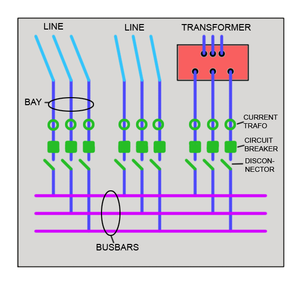
|
Gray: Substation Cyan: Power line Blue: Bay Green: Switches etc Purple: Busbar assembly Red: Transformer |
Switchgear

The switchgear assembly comprises one or more busbar assemblies and a number of bays each connecting a circuit to the busbar assembly. Normally the busbars and bays should be mapped individually, see below. However, sometimes the layout of the switchgear is not known, such as when the switchgear is inside a building or when no good aerial imagery is available. In such cases the switchgear may be mapped as an area. Only map switchgear in this way if it cannot be mapped in more details. If the entire substation is located indoor don't map the switchgear separately.
| Key | Value | Comment | Recommendation |
|---|---|---|---|
| power | switchgear |
Defines this |
mandatory |
| voltage | <voltage> | The voltage of the switchgear | recommended |
| location | <location> | The location of the switchgear, for example indoor. See above for possible values. | recommended |
| gas_insulated | yes | Use this tag for gas insulated switchgear using pressurized SF6 or SF6/nitrogen gas as insulation medium. | optional |
Busbar
The busbar assembly makes connection to one or more circuits via the attached bays. The assembly comprises either rigid tubular conductors or flexible conductors. Strictly spoken, the term busbar refers to just one conductor but commonly an assembly of three busbars is also called a busbar [2]] which is the definition used here.
| Key | Value | Comment | Recommendation |
|---|---|---|---|
| power | line |
Defines this |
mandatory |
| line | busbar |
Identifies the line as a busbar assembly | mandatory |
| cables | <3,6,..> | Number of individual conductors. It is recommended to map each three-phase busbar assembly individually. However, if double or triple busbars for some reasons are mapped as a single way the cables tag should be used to indicate this fact. | recommended |
| voltage | <voltage> | The voltage of the busbar | recommended |
Bay
A bay connects an incoming circuit (power line, transformer, etc) to a busbar assembly. Each bay typically comprises circuit breakers, disconnectors, instrument transformers and surge arresters. It is suggested not to tag all these individual components. However, the circuit breaker may optionally be tagged as a switch.
| Key | Value | Comment | Recommendation |
|---|---|---|---|
| power | line |
Defines this |
mandatory |
| line | bay |
Identifies the line as a bay | mandatory |
| cables | <3,6,..> | Normally bays should be mapped individually per circuit. However, if for some reasons the mapped cables=6 for two bays. |
recommended |
| voltage | <voltage> | The voltage of the bay | recommended |
Switch
A switch normally comprises a circuit breaker and is mostly found within bays but may also be used between busbar sections. Tag a ![]() as
as power=switch.
Transformer

A power transformer is a static piece of apparatus with two or more windings which, by electromagnetic induction, transforms a system of alternating voltage and current into another system of voltage and current for the purpose of transmitting electrical power [3]
A transformer is tagged as a ![]() . Transformers are usually located within substations and should be tagged as a node within an area tagged as
. Transformers are usually located within substations and should be tagged as a node within an area tagged as power=substation. However, small distribution transformers, such as those located in small kiosks may be tagged on their own as power=transformer without being associated with a substation object. Similarly, step-up transformers for generators within a power plant may be mapped without being inside a substation area.
For pole mounted transformers it is suggested to tag the pole as power=pole and add the tag transformer=distribution (or transformer=yes) (see below).
This proposal describes the attributes currently in use, that are not explained on the Tag:power=transformer wiki page, adds a location=* key for its physical location, and a transformer=* key to define its purpose.
| Key | Value | Comment | Recommendation |
|---|---|---|---|
| power | transformer |
Defines this node as a transformer. | mandatory |
| transformer | <purpose or type> | The purpose of the transformer (see below for possible values). | optional |
| location | <location> | The location of the transformer. Use the same values as for substation location, see above. If the location of the transformer is the same as that of its substation this tag is optional | recommended |
| voltage | <high voltage>;<low voltage> | The two (or more) voltages of this transformer, highest first, lowest then. A rural 20 kV/400 V is tagged 20000;400 whereas a high voltage 225 kV/400 kV transformer is tagged 400000;225000. Three-winding transformers should have three voltages listed even if two of them are identical |
recommended |
| frequency | <frequency> | The frequency of the transformer. Recommended if the frequency differs from that of the general power grid, for example 16.7 hz for the German railway traction. | optional |
| phases | 1, 3, .. | Number of phases. Recommended tag for for single-phase transformers. Default is 3. | optional |
| rating | <rating> kVA/MVA | The power rating of the transformer. The value should be in kVA (kilovolt-ampere) or MVA (megavolt-ampere) | optional |
General tags such as ref=* and operator=* may also be added when applicable.
| Key | Value | Comment |
|---|---|---|
| transformer | distribution | A distribution transformer transfers power from the distribution system to directly connected electricity consumers. Thus the output voltage is that of the low voltage grid in that region. For example 400/230 volt in Europe or 240/120 volt in the US. If the secondary voltage is above 1 kV it is not a distribution transformer. Note for pole mounted distribution transformers you should use this tag together with power=pole (thus no explicit power=transformer tag).
|
| generator | A generator unit transformer connects directly to the generator terminals and is used for stepping up the generator voltage to that of the transmission grid. It is almost always located physically close to the generator typically directly outside the generator building. Unless the generator terminal voltage is known it is sufficient to tag only the secondary voltage. | |
| converter | A converter transformer is a special transformer used in HVDC converter plants. It is always located directly adjacent to the valve hall. If the voltage of the valve side is unknown it is sufficient to tag the AC switchgear side voltage. | |
| traction | A traction transformer feeds railway overhead contact lines. It is usually a single-phase transformer whose secondary voltage is that of the contact line, typically 15 kV or 25 kV. | |
| auto | An autotransformer is a transformer in which part of the winding is common to both primary and secondary circuits. Sometimes used at modest voltage ratios between the primary and secondary. | |
| phase_angle_regulator | A phase angle regulator is a special transformer for controlling the flow of power in a three-phase network by shifting the phase angle. | |
| yes | This generic value may be used to tag a transformer attached to another power feature such as a power pole (since power=transformer cannot be tagged in such cases). It is however recommendend to specify the type of transformer (such as distribution) also in this case but mappers not familiar with the different flavours of transformers may use the value yes. |
For all power transformers not falling in one of the categories above no transformer attribute should be used.
Converter

An HVDC converter converts electric power from high voltage alternating current (AC) to high-voltage direct current (HVDC), or vice-versa.
An HVDC converter plant comprises several components. The valve hall comprises the converter itself. Further components include a DC smoothing reactor, converter transformers, AC switch gear, harmonic filters and reactive power compensation. See below for compensation components. The converter itself may be tagged as follows:
| Key | Value | Comment | Recommendation |
|---|---|---|---|
| power | converter |
Defines this node |
mandatory |
| converter | lcc | A line commutated converter (LCC) uses thyristor based valves and is the most common type. This is the default value. | recommended |
| vsc | A newer type is the transistor-based voltage source converter (VSC). | recommended | |
| back-to-back | A back-to-back converter couples two AC networks that are not synchronous or operate at different frequencies. There is no external DC power transmission link | recommended | |
| voltage | <DC voltage> | The voltage of the DC transmission in volt | recommended |
| poles | monopole / bipole | The number of poles. | recommended |
| rating | <power> MW | The power rating of the converter in MW (megawatt) | recommended |
General tags like name=* and operator=* may also be added.
Compensator

Various components are used for controlling reactive power and voltage quality in a power grid. Here are some suggested tags for different types of compensators.
| Key | Value | Comment | Recommendation |
|---|---|---|---|
| power | compensator |
Defines this node |
mandatory |
| compensator | <compensator type> | See below for possible values. This tag should be specified when the compensator type is known | recommended |
| voltage | <voltage> | The voltage at which the compensator is operated | recommended |
| rating | <power> Mvar/kvar | The power rating of the compensator. The unit should be Mvar (megavolt-ampere-reactive) or kvar (kilovolt-ampere-reactive) | recommended |
| Key | Value | Comment |
|---|---|---|
| compensator | shunt_reactor |
A shunt reactor absorbs excess reactive power. It looks like a transformer but has no secondary terminals. |
shunt_capacitor |
A shunt capacitor bank generates reactive power | |
static_var |
A static var compensator (SVC) comprises a thyristor controlled reactor, normally a thyristor switched capacitor and often fixed or switched reactors and capacitor banks. | |
statcom |
A static synchronous compensator (STATCOM) is a transistor based compensator (its design is similar to a VSC converter, see above). | |
synchronous_condenser |
A synchronous condenser is a large rotating synchronous machine (similar to a generator) for generating or absorbing reactive power. | |
filter |
A harmonic filter is used to eliminate harmonic currents generated by an HVDC converter. These can be quite large and may appropriately be mapped as | |
series_reactor |
A series reactor is used for controlling load sharing between parallel power lines or for limiting short circuit currents. The smoothing reactor of an HVDC converter is also a series reactor. | |
series_capacitor |
A series capacitor is sometimes inserted in a long power line to increase the transmission capacity. |
Examples
| Maperitive | Mapnik | Tagging | Note |
|---|---|---|---|
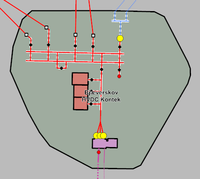 white-dashed:bay, red:400kV, blue:132kV, purple:converter,DC line/cable, yellow:transformer, black:switch, red circle:reactor, read area:filter |
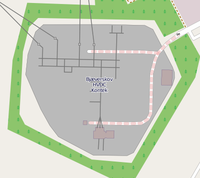 |
power=substationsubstation=convertername=Bjæverskov HVDC Kontekvoltage=400000;132000(valve hall) building=yespower=convertername=HVDC Kontekoperator=Energinet.dkpoles=monopolerating=600 MWvoltage=400000 |
Bjæverskov HVDC substation in Denmark (northern terminal of Kontek HVDC connection). Bing imagery of the substation. |
| Photo | Tagging | Note |
|---|---|---|
 |
power=substationsubstation=transmissionvoltage=380000;150000(each transformer) power=transformervoltage=380000;150000rating=500 MVA |
Very compact 380/150 kV substation in Westerlee, Netherlands. Despite its small size it is equipped with three 500 MVA transformers. Mapnik map. |
 |
power=substationsubstation=distributionvoltage=25000;10000location=indoor |
Indoor 25/10kV substation near The Hague. |
 |
power=transformertransformer=distributionvoltage=10000;400location=kiosk |
Prefab 10/0.4kV transformer kiosk near The Hague. |
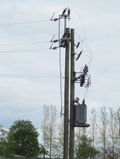 |
power=poletransformer=distributionvoltage=10000;400 |
Typical pole mounted 10 kV transformer. |
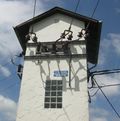 |
power=substationvoltage=10000;400substation=distributionbuilding=yes |
Characteristic tower type transformer building functioning as an electricity pole. Maybe use building=transformer_tower? (not part of this proposal)
|
Rendering
Many of the proposed tags are mostly of special user interest and general purpose renders should probably ignore them. Here are some suggestions on features that may be rendered by general purpose renderers.
power=substationshould be rendered like the currentpower=sub_stationtag, i.e. as a gray area.power=linein combination with theline=bay/busbartag may be rendered like a normal power line. However, renderers may also choose to selectively render busbars and bays according to zoom level (maybe only at the highest zoom levels 17 and 18).power=transformermay be rendered at very high zoom levels (17 and 18). The symbol could be either a small lightning symbol or a small circle.- Other power features are probably only relevant to special purpose theme maps.
Tools/Renderers affected
- JOSM : Case #9169 opened on the dev trac : http://josm.openstreetmap.de/ticket/9169
Deprecated tags
| Deprecated tag | Used for ? | New tag(s) to use |
|---|---|---|
power=station |
Power plant | power=plant (and power=generator for individual generators within the plant).
|
power=station |
Substation | power=substation
|
power=sub_station |
Substation | power=substation
|
See also
- Power generation refinement: The parent proposal now only dealing with power generation.
- Proposed_features/Power_transmission_refinement: A related proposal dealing with power lines.
- Power_substations: A small tutorial on power substations (with some deviating tagging from this proposal).
- Power_lines: An article on power lines (with authors ideas about some tagging).
Voting
The voting has finished. The result is 22 votes in favour of the proposal and 2 against. The proposal has been approved.
 I approve this proposal. --polderrunner (talk) 20:26, 22 September 2013 (UTC)
I approve this proposal. --polderrunner (talk) 20:26, 22 September 2013 (UTC) I approve this proposal. --Fanfouer (talk) 20:41, 22 September 2013 (UTC)
I approve this proposal. --Fanfouer (talk) 20:41, 22 September 2013 (UTC) I approve this proposal. --Alexrollin (talk) 03:47, 23 September 2013 (UTC)
I approve this proposal. --Alexrollin (talk) 03:47, 23 September 2013 (UTC) I approve this proposal. --Imagic (talk) 06:39, 23 September 2013 (UTC)
I approve this proposal. --Imagic (talk) 06:39, 23 September 2013 (UTC) I approve this proposal. --Bredy (talk) 08:18, 23 September 2013 (UTC)
I approve this proposal. --Bredy (talk) 08:18, 23 September 2013 (UTC) I approve this proposal. --Pieren (talk) 09:54, 23 September 2013 (UTC)
I approve this proposal. --Pieren (talk) 09:54, 23 September 2013 (UTC) I approve this proposal. --hendrik-17(talk) 16:54, 23 September 2013 (UTC)
I approve this proposal. --hendrik-17(talk) 16:54, 23 September 2013 (UTC) I approve this proposal. But I don't like mixing large substations (the former power=station) and transformer houses (small buildings at streets, the former power=sub_station) into the same tag. --Surly (talk) 19:36, 23 September 2013 (UTC)
I approve this proposal. But I don't like mixing large substations (the former power=station) and transformer houses (small buildings at streets, the former power=sub_station) into the same tag. --Surly (talk) 19:36, 23 September 2013 (UTC) I approve this proposal. -- HillWithSmallFields (talk) 12:34, 26 September 2013 (UTC)
I approve this proposal. -- HillWithSmallFields (talk) 12:34, 26 September 2013 (UTC) I approve this proposal. -- FreeExec (talk) 17:39, 26 September 2013 (UTC+4)
I approve this proposal. -- FreeExec (talk) 17:39, 26 September 2013 (UTC+4) I approve this proposal. -- S777n (talk) 14:04, 26 September 2013 (UTC)
I approve this proposal. -- S777n (talk) 14:04, 26 September 2013 (UTC) I approve this proposal. -- Citrin (talk) 16:14, 26 September 2013 (UTC)
I approve this proposal. -- Citrin (talk) 16:14, 26 September 2013 (UTC) I approve this proposal. Lzhl (talk) 21:35, 26 September 2013 (UTC).
I approve this proposal. Lzhl (talk) 21:35, 26 September 2013 (UTC). I approve this proposal. --AMDmi3 (talk) 14:58, 27 September 2013 (UTC)
I approve this proposal. --AMDmi3 (talk) 14:58, 27 September 2013 (UTC) I approve this proposal. Sbiribizio (talk) 15:46, 27 September 2013 (UTC)
I approve this proposal. Sbiribizio (talk) 15:46, 27 September 2013 (UTC) I approve this proposal. Plop76 (talk) 20:31, 27 September 2013 (UTC)
I approve this proposal. Plop76 (talk) 20:31, 27 September 2013 (UTC) I approve this proposal. -- Al3xius (talk) 07:22, 29 September 2013 (UTC)
I approve this proposal. -- Al3xius (talk) 07:22, 29 September 2013 (UTC) I approve this proposal. Progserega (talk) 03:20, 2 October 2013 (UTC)
I approve this proposal. Progserega (talk) 03:20, 2 October 2013 (UTC) I approve this proposal. I hope this proposal will help me better map the transformer houses above, seen very often in this region. (Please add/complete its correct tagging.) --Segatus (talk) 12:03, 3 October 2013 (UTC)
I approve this proposal. I hope this proposal will help me better map the transformer houses above, seen very often in this region. (Please add/complete its correct tagging.) --Segatus (talk) 12:03, 3 October 2013 (UTC) I approve this proposal. -- JaakkoH (talk) 21:16, 3 October 2013 (UTC)
I approve this proposal. -- JaakkoH (talk) 21:16, 3 October 2013 (UTC) I approve this proposal. Mercator (talk) 10:35, 4 October 2013 (UTC)
I approve this proposal. Mercator (talk) 10:35, 4 October 2013 (UTC) I oppose this proposal. The conventional tags are used abundantly all over central Europe. Deprecating them without a proper migration plan for existing data is a botch. We'll end up with 2 concurrent tagging schemes that applications need to know about. Throwing away the distinction between what we use to tag power=station and power=sub_station is another awful idea. These correspond with terms in common German language (Umspannwerk vs. Trafohäuschen), so they should be represented with separate tags in OSM as well. Every mapper can easily distinguish them, while only experts know about the voltage. If the english tag names don't reflect technical use, find better tag names, instead of losing information. --Fkv (talk) 18:52, 4 October 2013 (UTC)
I oppose this proposal. The conventional tags are used abundantly all over central Europe. Deprecating them without a proper migration plan for existing data is a botch. We'll end up with 2 concurrent tagging schemes that applications need to know about. Throwing away the distinction between what we use to tag power=station and power=sub_station is another awful idea. These correspond with terms in common German language (Umspannwerk vs. Trafohäuschen), so they should be represented with separate tags in OSM as well. Every mapper can easily distinguish them, while only experts know about the voltage. If the english tag names don't reflect technical use, find better tag names, instead of losing information. --Fkv (talk) 18:52, 4 October 2013 (UTC)
- You missed the point that the German interpretation is different from the English interpretation. This is an old well known issue. This proposal is trying to clean-up the mess and improve things. The migration plan can be discussed later once the new scheme is adopted. Tomorrow is another day. --Pieren (talk) 11:39, 8 October 2013 (UTC)
- Judging from wikipedia, I understand that Trafohäuschen is the small building or even a box housing a single transformer. In that case it should be mapped as power=transformer and that way it'll be well distinctive from power=substation. In Russia have a similar distinction: power=station was used for large outdoor substations and power=sub_station was used for smaller ones which power a neighborhood (http://photos.wikimapia.org/p/00/03/18/31/60_full.jpg, http://foto.cheb.ru/foto/28720.htm). However the fact is that those should NOT have different primary tags: these are both substations and host multiple transformers. The difference is only the voltage or being a single building, which should be expressed in corresponding separate tags. I thus still find the new schema superior in all ways. --AMDmi3 (talk) 18:18, 31 October 2013 (UTC)
 I approve this proposal. − JB (talk) 14:58, 7 October 2013 (UTC)
I approve this proposal. − JB (talk) 14:58, 7 October 2013 (UTC) I oppose this proposal. Same reasons as Fkv --EvanE (talk) 17:08, 7 October 2013 (UTC)
I oppose this proposal. Same reasons as Fkv --EvanE (talk) 17:08, 7 October 2013 (UTC) I approve this proposal. − FK270673 (talk) 18:11, 8 October 2013 (UTC)
I approve this proposal. − FK270673 (talk) 18:11, 8 October 2013 (UTC)- I dontvote this proposal. make suggestions, but seriously, there are over a million mappers, and you think that a vote of 24 people has any bearing on how they will map? Document how you map; map according to the documentation unless you think there's a better way, in which case you document how you map; but never never change the meaning of existing tags. Now, if you want to have a Union of Concerned Mappers, all of whom agree to abide by a vote of the group, and recommend mapping a certain way, go for it! Great! But the wiki should always be descriptive of how people edit, not prescriptive. RussNelson (talk) 06:48, 18 October 2013 (UTC)